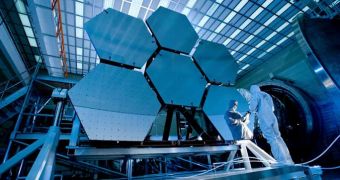According to a recent cost analysis, it would appear that the next-generation space telescope that the American space agency is building will cost some $1.5 billion more than originally estimated. The panel that conducted the study says that the planned launch date will also slip further away, by 15 months minimum.
The findings belong to an independent review panel, which was called into action by US Senator Barbara Mikulski (D-Md.), to check up on what was happening with the soaring costs and management issues that plagued the development of the James Webb Space Telescope (JWST).
The instrument is the most complex observatory to ever fly, and it was designed specifically to take the place of the famous Hubble Space Telescope. As such, it has some pretty big shoes to fill, and NASA wanted to create the very best tool, that would incorporate the most ground-breaking capabilities.
“The Webb telescope will now cost $6.5 billion, $1.5 billion more than the estimate included in NASA's February 2010 budget request. Its launch will be delayed by over a year, from June 2014 to September 2015,” said the senator in a letter sent to NASA Administrator Charles Bolden.
Mikulski sent the document on November 10, after carefully reviewing the independent report, which she received on October 29, Space reports. The JWST development effort is being led by teams at the NASA Goddard Space Flight Center, in Greenbelt, Maryland.
The soaring costs associated with constructing this machine are perhaps better understood when considering its size and capabilities. It will feature a five-layer sunshield unlike anything built before. The shield will be foldable, and will cover about the surface of a tennis court.
Its primary instrument will be a 6.5-meter foldable mirror, which will contain numerous smaller segments. Each of them needs to be polished within a degree of accuracy that was never achieved before on a space observatory.
Redondo Beach, California-based Northrop Grumman was selected as the prime contractor for the construction of the JWST, which is being assembled at Goddard. The European Space Agency (ESA) is involved in the project as well, as it will be providing the Ariane 5 heavy-lift delivery system needed to take the JWST to a transfer orbit.
The observatory will then deploy at the L2 Lagrangian point, which is a spot at a very precise location away from Earth where it will remain in the same relative position from the Sun-Earth-Moon system. Once there, it will deploy its sunshield to avoid any stray light penetrating its detectors.
Until then, however, Mikulski instructed Bolden to patch things up in JWST upper management, and to streamline the production process. “We cannot afford to continue with business as usual in this stark fiscal situation,” she said.
The independent review panel calls the technical progress made by the JWST team as “commendable and often excellent,” but stress that issues arise on account of “budgeting and program management, not technical performance.”

 14 DAY TRIAL //
14 DAY TRIAL //